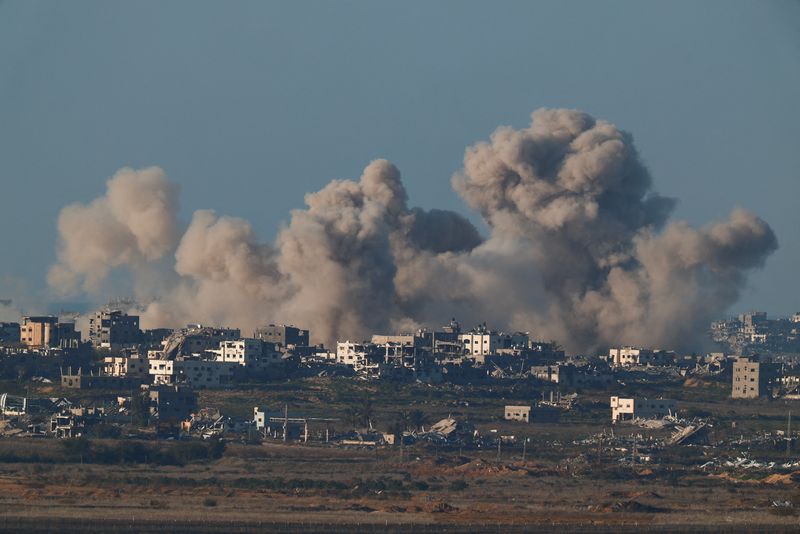Written by Alexander Cornwell and Nidal Al-Mughrabi
JERUSALEM/CAIRO (Reuters) – Israel agreed on Saturday to a ceasefire agreement with the Islamic Resistance Movement (Hamas) that includes the release of hostages in the Gaza Strip, and Israeli forces carried out raids in the Strip before the start of the agreement scheduled for Sunday.
The agreement is set to end the 15-month-old war between Israel and the Hamas movement that rules Gaza, which has devastated the Gaza Strip, killed tens of thousands of Palestinians and destabilized the Middle East.
The war was sparked by an October 7, 2023 Hamas attack on southern Israel in which 1,200 people were killed and more than 250 were taken hostage, according to Israeli statistics. More than 400 Israeli soldiers have been killed in fighting in Gaza since then.
Early on Saturday, after a meeting that lasted more than six hours, the Israeli government ratified the ceasefire agreement that aims to stop the fighting and release dozens of hostages held by Hamas in exchange for the release of dozens of Palestinians imprisoned in Israel.
Netanyahu’s office said in a brief statement, “The government approved the framework for the return of the hostages. The framework for the release of the hostages will enter into force on Sunday.”
In Gaza, Israeli warplanes have continued their attacks since the agreement was agreed upon, and bombed the Strip on Saturday.
Residents said that Israeli tanks bombed the Al-Zaytoun neighborhood in Gaza City, and air strikes also bombed the center and south of the Strip. Medics in Gaza said that five people were killed in an air strike that hit a tent in the Al-Mawasi area, west of the city of Khan Yunis.
The Israeli military said that since Friday it had bombed Hamas and Islamic Jihad fighters who were among 50 “terrorist targets” it had bombed across the Gaza Strip.
The Palestinian Civil Emergency Service said that at least 123 Palestinians have been killed in Israeli raids since the ceasefire agreement was announced on Wednesday.
Nearly 47,000 people have been killed since the beginning of the war, according to the Palestinian Ministry of Health.
The first hostages will be released on Sunday
Outside Gaza, the conflict has sent shockwaves across the region, sparking a war with Lebanon’s Hezbollah and bringing Israel into direct conflict with Iran for the first time.
Since the beginning of the Gaza war, Yemen’s Houthis, also backed by Iran, have carried out hundreds of attacks on what they say are Israeli-linked cargo ships traveling through the Red Sea and have fired missiles at Israel, which has responded with air strikes in Yemen. .
At least two missiles were fired from Yemen on Saturday, triggering sirens in Tel Aviv, Jerusalem and the southern resort of Eilat before they were intercepted, the Israeli military said.
In Tel Aviv, police said that a Palestinian stabbed and injured a person before a bystander shot him. His condition was not immediately clear.
A Qatari Foreign Ministry spokesman said on the X website that the ceasefire in Gaza will enter into force at 0630 GMT on Sunday. The White House expects to release three hostages to Israel in the afternoon through the Red Cross.
Under the agreement, the three-phase ceasefire begins with an initial six-week phase in which hostages held by Hamas are exchanged for prisoners and detainees imprisoned in Israel.
At this stage, 33 of the remaining 98 Israeli hostages are scheduled to be released, including women, children, men over the age of 50, and sick and wounded prisoners. In return, Israel will release approximately 2,000 Palestinians from its prisons.
They include 737 male and female prisoners and teenagers, some of whom are members of armed groups convicted of attacks that killed dozens of Israelis, as well as hundreds of Palestinians from Gaza who have been detained since the beginning of the war.
The Israeli Ministry of Justice published the details early Saturday along with a ceasefire agreement that stipulated the release of 30 Palestinian prisoners for every hostage on Sunday.
After the hostages were released on Sunday, chief US negotiator Brett McGurk said the agreement called for the release of four more hostages after seven days, followed by the release of three more hostages every seven days after that.
With some hardliners in the Israeli government opposing the agreement, media reports stated that 24 ministers in Netanyahu’s coalition government voted in favor of the agreement, while eight opposed it.

Opponents said that the ceasefire agreement represented a surrender to Hamas. National Security Minister Itamar Ben Gvir threatened to resign if approved and urged other ministers to vote against it. But he said he would not topple the government.
Finance Minister Bezalel Smotrich also threatened to resign from the government if it did not return to war to defeat Hamas after the first six-week phase of the ceasefire.
https://i-invdn-com.investing.com/news/world_news_3_69x52._800x533_L_1419494235.jpg
Source link